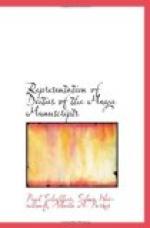1. The mouth encircled by a red-brown border.
2. The large, drooping under lip. By this he can be recognized with certainty also in Dr. 43a.
3. The two curved lines at the right of the eye.
His significance can be conjectured. He seems to be of a warlike nature, for he is almost always represented armed with the lance and also as engaged in combat and, in some instances, pierced by the lance of his opponent, god F, for example in Tro. 3c, 7a, 29*a. The peculiar object with parallel stripes, which he wears on his head is a rope from which a package frequently hangs. By means of a rope placed around his head the god frequently carries a bale of merchandise, as is the custom today among the aborigines in different parts of America. On 4b and 5a in the Cod. Tro. this can plainly be seen. All these pictures lead us to conclude, that we have here to do with a god of travelling merchants. A deity of this character called Ekchuah has been handed down to us, who is designated explicitly as a black god. In favor of this is also the fact, that he is represented fighting with F and pierced by the latter. For the travelling merchant must, of course, be armed to ward off hostile attacks and these are admirably symbolized by god F, for he is the god of death in war and of the killing of the captured enemy. The god is found in the Codex Troano in the following places and on many pages two or three times: pp. 2, 3, 4, 5, always with the hieroglyph, then without it on pp. 6, 7, 19, 4*c, 14*b, 17*a, 18*b and again with the hieroglyph on pp. 22*a, 23*a, 25*a; finally it is found again without the hieroglyph on pp. 29*a, 30*a, 31*, 32*, 33*, 34*. In the Codex Cortesianus god M occurs in the following places: p. 15, where he strikes the sky with the axe and thus causes rain, p. 19 (bottom), 28 (bottom, second figure), 34 (bottom) and 36 (top). M is always to be recognized by the encircled mouth and the drooping under-lip; figures without these marks are not identical with M, thus for example in Tro. 23, 24, 25, 21*. Tro. 34*a shows what is apparently a variant of M with the face of an old man, the scorpion’s tail and the vertebrae of the death-god, a figure which in its turn bears on its breast the plainly recognizable head of M. God M is also represented elsewhere many times with the scorpion’s tail, thus for example on Tro. 30*a, 31*a.
Besides his hieroglyph mentioned above, Figs. 45 and 46, another sign seems to refer to god M, namely Fig. 48 (compare for example Tro. 5a and Cort. 28, bottom). The head in this sign has the same curved lines at the corner of the eye as appear on the deity himself. Foerstemann mentions this sign in his Commentary on the Paris Manuscript, p. 15, and in his Commentary on the Dresden Manuscript, p. 56. He thinks the hieroglyph has relation to the revolution of Venus, which is performed in 584 days. A relation of this kind is, I think, very possible, if we bear in mind that all the god-figures of the manuscripts have more or less of a calendric and chronologic significance in their chief or in their secondary function.




